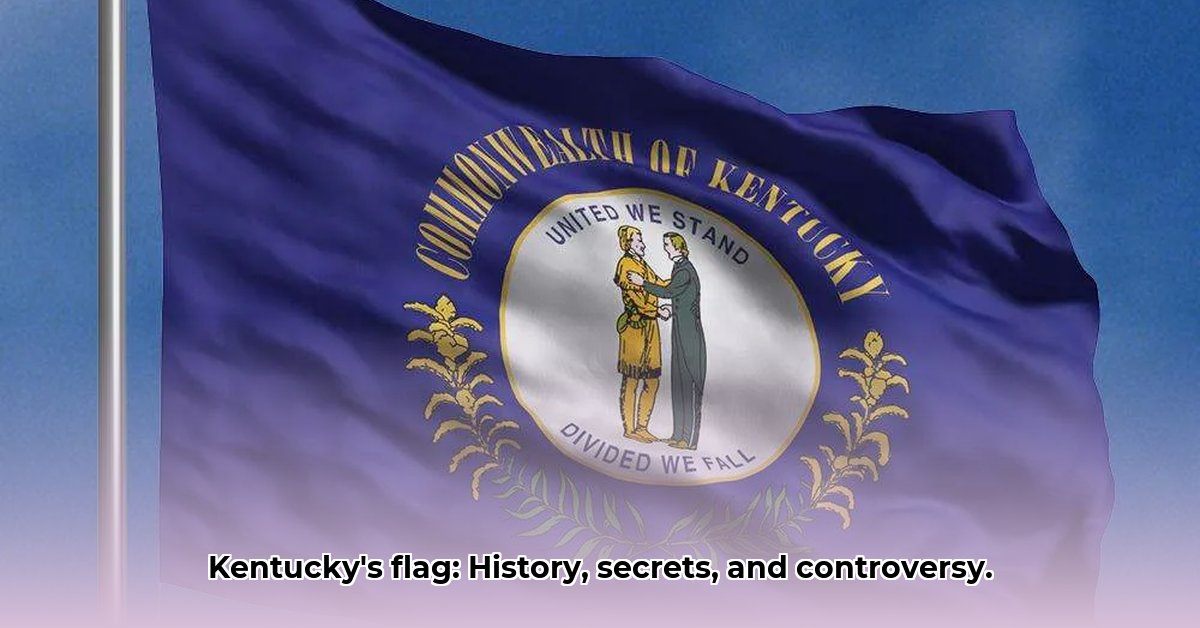Kentucky’s state flag, a navy blue field showcasing the state seal, is more than just a visual representation; it’s a living testament to the Commonwealth’s rich history, its evolving identity, and its ongoing pursuit of unity. From its adoption in 1918 to subtle yet significant revisions, the flag’s journey mirrors Kentucky’s own transformation from frontier territory to a complex modern state. For comparison, see the Pennsylvania state flag. This exploration delves into the flag’s symbolism, its historical context, and the debates that continue to shape its meaning in the 21st century.
A Frontier Embrace: Deciphering the Seal
The heart of the Kentucky flag lies in its state seal, a powerful symbol that has sparked continuous discussion and varying interpretations. The central image of two men embracing—often identified as a frontiersman clad in buckskins and a statesman in formal attire—embodies the state’s motto: “United We Stand, Divided We Fall.” This embrace represents more than just a physical act; it symbolizes the crucial partnership between Kentucky’s early pioneers and its burgeoning political leadership, a union essential for the state’s survival and growth. However, the figures also represent a broader ideal—the unity of all Kentuckians, regardless of background or belief. This inclusive interpretation reinforces the motto’s message, highlighting the strength found in collective action and the potential for weakness in division. The ongoing debate surrounding the figures’ specific identities—whether they represent historical individuals or symbolic archetypes—further enriches the seal’s meaning, inviting continuous reflection on Kentucky’s diverse heritage.
Evolution of an Emblem: Adapting to Change
The Kentucky flag has undergone several revisions throughout its history, each alteration reflecting shifts in societal values and design preferences. The original 1918 flag presented a highly detailed state seal, a product of its time, emphasizing intricate craftsmanship. However, this detail proved challenging for accurate reproduction. The 1962 modification addressed this issue by simplifying the seal, making it easier to replicate across various mediums. While this change enhanced the flag’s practicality, it also triggered debate about the potential loss of historical nuance. Subsequent revisions, including the 2020 addition of a star, introduced another layer of symbolism while further streamlining the design. The star, a symbol often associated with achievement and aspiration, potentially represents Kentucky’s status as the 15th state to join the Union, connecting the flag to the broader narrative of American history. These changes demonstrate the flag’s dynamic nature, its ability to adapt and evolve while retaining its core message of unity and progress.
Beyond the Blue Field: Color, Context, and Controversy
The Kentucky flag’s navy blue field, a common color choice among state flags, represents loyalty and steadfastness. While often linked to Kentucky’s allegiance to the Union during the Civil War, the blue also carries a broader significance, symbolizing the state’s commitment to its principles and its unwavering spirit. However, the widespread use of blue in other state flags raises questions about its unique relevance to Kentucky’s identity. This ambiguity encourages deeper exploration of the flag’s symbolism, prompting us to consider the specific historical and cultural contexts that imbue the blue with meaning for Kentuckians. Furthermore, the ongoing discussions around the flag’s design and the interpretation of its elements highlight the importance of continuous dialogue about its symbolism. This discourse ensures that the flag remains a relevant and representative emblem for all Kentuckians.
The Kentucky Flag Today: A Shared Heritage
The Kentucky flag in the 21st century stands as a powerful symbol of the Commonwealth’s shared heritage, its commitment to unity, and its continuous evolution. It’s a reminder of the struggles and triumphs that have shaped Kentucky’s identity, and it serves as an inspiration for future generations. By engaging in meaningful dialogue about the flag’s history and its evolving symbolism, Kentuckians can foster a deeper understanding of their collective past, present, and future. The flag serves as a visual touchstone, uniting citizens under a common banner and encouraging them to uphold the values of cooperation, resilience, and progress that have defined the Commonwealth throughout its history.










